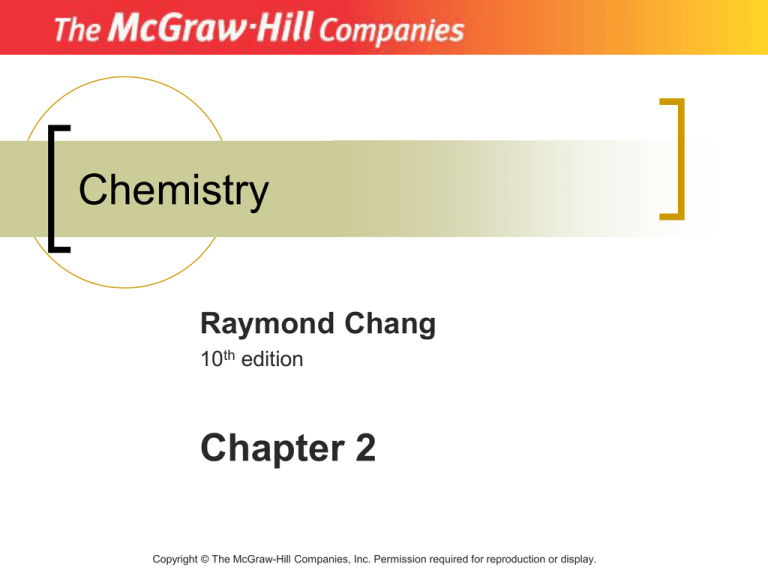Chemistry Chapter 2 Raymond Chang 10
advertisement

Chemistry Raymond Chang 10th edition Chapter 2 Copyright © The McGraw-Hill Companies, Inc. Permission required for reproduction or display. Question 1 The nucleus of an atom is positively charged due to the neutrons present. A) True B) False 50% 50% 1 2 Question 2 Most of the mass of an atom is contained in the nucleus. A) True B) False 50% 50% 1 2 Question 3 The atomic number of an neutral atom is the same as the number of protons or electrons. A) True B) False 50% 50% 1 2 Question 4 Which of the following combinations of protons (p), neutrons (n), and electrons (e), respectively, is possible for a neutral 25% 25% 25% 25% carbon atom? A) 6p, 5n, 7e B) 12p, 6n, 6e C) 6p, 7n, 6e D) 6p, 7n, 7e 1 2 3 4 Question 5 Which of the following combinations of protons (p), neutrons (n), and electrons (e), respectively, is possible for a chloride ion? 25% 25% 25% 2 3 25% A) 17p, 18n, 17e B) 17p, 20n, 18e C) 16p, 19n, 17e D) All are possible 1 4 Question 6 Which of the following list a metal, a nonmetal, and a noble gas, respectively? 25% 25% 25% 2 3 25% A) Au, P, Ne B) Ne, Ar, Cl C) Au, Pt, He D) Au, P, H 1 4 Question 7 What is the empirical formula of a compound that contains molecules composed of 3 carbon atoms and 6 hydrogen atoms? 25% 25% 25% 25% A) CH2 B) C2H4 C) C3H6 D) All of the above 1 2 3 4 Question 8 The compound dinitrogen monoxide could be classified as 25% 25% 25% 25% A) a molecular compound. B) an ionic compound. C) a binary compound. D) A or C. 1 2 3 4 Question 9 Which of the following chemical names could refer to more than one common 25% 25% 25% compound? 25% A) calcium hydroxide B) copper chloride C) sodium sulfide D) lithium nitrate 1 2 3 4 Question 10 Which of the following formulas refers to the sulfate ion? 25% 25% 25% 2 3 25% A) SO42B) SO4 C) SO32D) SO3 1 4 Question 11 The law of definite proportions was published by 20% 20% 20% 2 3 20% 20% A) Dalton. B) Proust. C) Einstein. D) Thomson. E) Millikan. 1 4 5 Question 12 Which of the following is not an elementary 20% 20% 20% 20% 20% subatomic particle? 1. 2. 3. 4. 5. A) Neutron B) Proton C) Electron D) a particle E) b particle 1 2 3 4 5 Which of the following statements is false ? A) A neutron is about 1840 times heavier than an electron B) An electron is about 1840 times lighter than a proton C) A proton has the same charge magnitude as an electron D) A neutron has about the same mass as a proton E) All the charge of an atom is concentrated in its nucleus 20% 1 20% 20% 2 3 20% 4 20% 5 Question 14 Which is the appropriate symbol for an isotope with Z = 75 and A = 187? 20% 20% 20% 2 3 20% 20% A) 75 Re 75 Re B) 187 C) 187 75 Re D) 112 75 Re E) 187 75 W 262 1 4 5 Question 15 Which of the following is not the common name of a group of elements in the Periodic Table? 20% 20% 20% 20% 20% A) alkali metals B) transition metals C) halogens D) inert gases E) alkali earth metals 1 2 3 4 5 Question 16 The species Hg22+ is an example of 20% 20% 20% 2 3 20% 20% A) a monoatomic cation. B) a polyatomic cation. C) a monoatomic anion. D) a polyatomic anion. E) a polyatomic metal. 1 4 5 Question 17 What is the name of Cr2(Cr2O7)3? 20% 20% 20% 2 3 20% 20% A) chromium (II) dichromate B) chromium (II) trichromate C) chromium (III) heptoxide D) chromium (III) heptaoxide E) chromium (III) dichromate 1 4 5 Question 18 Which of the following represents the salt cobaltic thiocyanate? 20% 20% 20% 20% 20% A) Co(CN)2 B) Co(SCN)2 C) Co(CN)3 D) Co(SCN)3 E) none of the above 1 2 3 4 5 Question 19 Which of the following formulas does not represent a real compound? 20% 1. 2. 3. 4. 5. 20% 20% 2 3 20% 20% A) CuOH B) MnO2 C) Al2(HPO4)3 D) (NH4)2Cr2O7 E) NaCO3 1 4 5 Question 20 Which of the following is most similar in properties to cupric sulfate? 20% 20% 20% 2 3 20% 20% A) CuSO3 B) Cu2SO3 C) Cu2SO4 D) CuSO4 • 5 H2O E) CuS 1 4 5 Answer Key – Chapter 2 1. 2. 3. 4. 5. 6. 7. 8. 9. 10. B A A C B A A D B A 11. 12. 13. 14. 15. 16. 17. 18. 19. 20. B D E C B B E D E D




